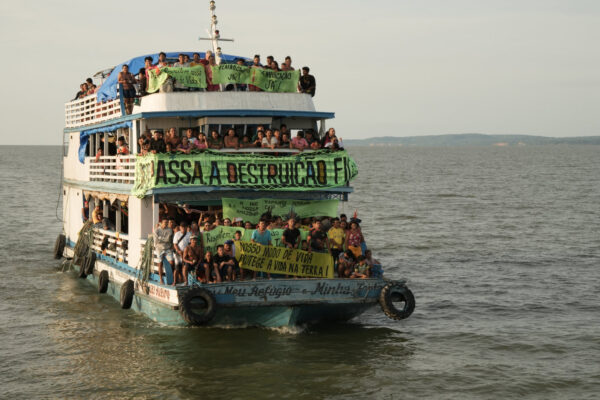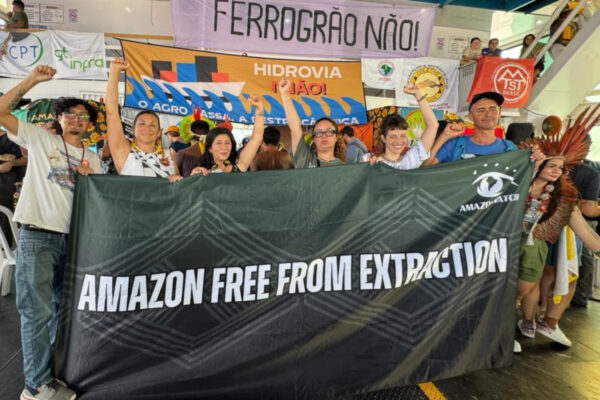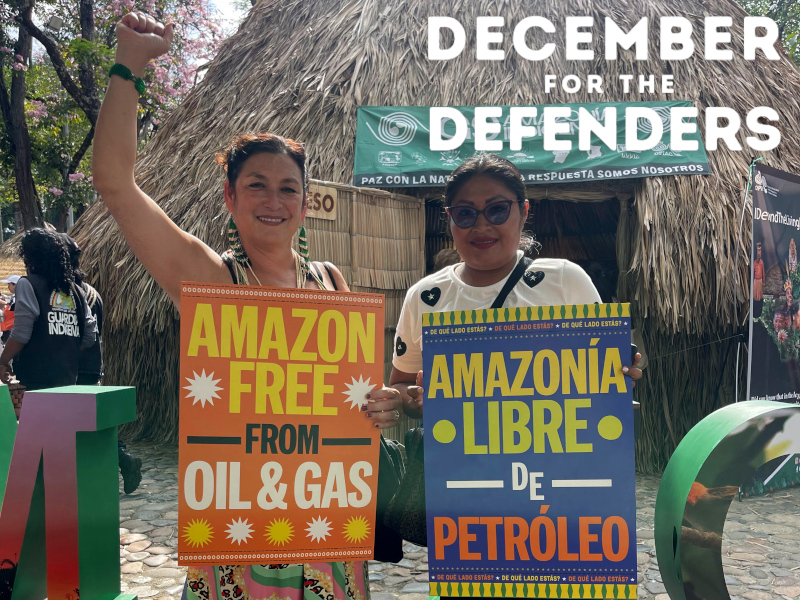Publicity for “The Green Inferno,” the latest film by “torture porn” film director Eli Roth, left our team at Amazon Watch in disbelief that anyone thought making a film based around the retrograde stereotype of the savage cannibal indigenous tribe was an acceptable idea in 2015. Understanding that controversy might well boost ticket sales, we debated whether to denounce, deride, or simply ignore the film.
Eli Roth helped make the decision for us. In an exchange on Instagram with an incensed activist, he defended the film in part by claiming that “Amazon Watch saw the film and loved it!” Extraordinarily, his response was effective in momentarily defusing outrage about the film.
In fact, Roth was either lying or simply misinformed – at that point we had definitely not seen the film. We were, however, able to put together an exhaustive plot summary based on reviews, YouTube clips, and conversations with people who had seen advanced screenings. In the end, this summary did accurately represent most of the elements of the film. Based on that analysis, our esteem of “The Green Inferno” was something other than us “loving it”.
In addition to issuing our own initial statement against the film, we supported statements made by indigenous activists both in Peru and here in North America.
Still, doubts persisted about the veracity of our critique given we hadn’t seen the film. So last night we went and sat through it. And now, on the occasion of its national release, we can definitively say “The Green Inferno” is indeed racist, just plain absurd, and frankly not particularly scary.
To sum up the plot: A group of university activists – some duplicitous and the rest just naive – travel from New York City to the Peruvian Amazon to protest rainforest destruction in the name of “saving a dying tribe.” They carry out a civil disobedience direct action against a gas exploration project that threatens the Yagé people (fictional group) by chaining themselves to the bulldozers that are knocking down trees while implausibly livestreaming the action via social media. Later we learn their stunt was bankrolled by the gas company’s competitor as a means of gaining a competitive advantage and taking over the project, a fact known in advance by the shady ring-leader, Alejandro.
After a seemingly successful action, their Cessna plane crashes as they head home. “Ironically,” they land in the territory of the Yagé people, who capture and imprison them in the center of the village. Starting with a grisly ceremony in which an activist’s eyeballs are extracted, tongue is cut out, and limbs systematically hacked off, most of the others are killed, cooked, and eaten one by one. Escape attempts are unsuccessful. Inexplicably, the main protagonist Justine is selected for female genital mutilation, a practice that, like cannibalism, doesn’t exist in the Amazon.
Justine is barely saved from the ritual when the entire town rushes off to fight the encroaching workers and their mercenary guards. She is freed by the one sympathetic indigenous character, a little girl whom she had befriended while in the cage. Escaping the village, Justine encounters the violent confrontation between the workers and villagers, in which the mercenaries are slaughtering many tribesman with their automatic weapons. She intervenes, pretending to use a smartphone to document the atrocities and incredibly, stops further bloodshed. Following an airlift home, Justine debriefs with diplomatic officials and claims that the tribe in fact saved her life and in a display of Stockholm syndrome, claims that they are not cannibals. In a post-credits scene, a satellite image of the village shows that Alejandro survived and has ‘gone native,’ having assumed black body paint previously sported by the head-chopping chief cannibal.
What are our key take-aways from “The Green Inferno”?
The inherent racism of an Amazonian cannibal movie is on full display. A false stereotype of the animalistic and brutal indigenous savage is a central conceit of the film. Other than the fake name of the tribe, no indigenous person has a name, nor says anything intelligible, nor is otherwise humanized – the one exception being the young girl who miraculously transcends her people’s mob mentality and liberates Justine. The experience of the white people, who have names and motivations – as shallow as they might be – is entirely central to the plot. The degree to which the film evokes any emotional response, it’s supposed to be some kind of horror at harm befalling the gringos. In dialogue between the activists, there are various references to “what they are doing to us.” This is a classic example of othering.
Roth’s portrayal of activism is absurd and cartoonish. Ostensibly, the film’s social subtext is a critique of “slactivism,” inspired by what Roth apparently observed around phenomenon like Occupy Wall Street and Kony 2012. But, as numerous reviewers have noted, “slactivists” wouldn’t travel to Peru and carry out a direct action in the middle of the rainforest. The extreme naivete or venality of members of this group reaches caricature proportions. In all, it’s not a serious social commentary, between being incoherent and hyperbolic. Unfortunately, this makes it all the more pointless, because there are cogent critiques to be made of well-meaning but clueless activists who ultimately do more harm than good, protected by their privilege from paying any consequences – like Roth himself.
There are some real-life issues illustrated in the film, but to such exaggeration that any prospective value in raising awareness about the Amazon is completely lost. Yes, there are gas and other extractive projects in the Amazon menacing indigenous peoples within their own territories today. But the lethal threat is generally not armed mercenaries that will shoot indigenous natives, instead risks posed by foreign disease or adverse health effects from pollution are far more likely to have an impact. Yes, Amazonian indigenous peoples tend to resist unwanted incursions into their territories, but they don’t systematically mutilate and murder the invaders. In the overwhelming preponderance of cases, indigenous peoples defend themselves through nonviolent and often sophisticated means using lawsuits, protests, and their own media campaigns.
A little over a month ago, Roth claimed that he “made “The Green Inferno” to spark discussion and bring awareness to the devastation these tribes face at the hands of corporations.” The belated expression of attempted social relevance smacks of opportunism, especially coming on the heels of several strong criticisms from indigenous peoples themselves. Beyond the collaboration with Mongabay, the practical utility of which remains to be seen, how is the film actively “sparking discussion”? We’ve only seen a slick online marketing campaign, and have to assume those comments were a disingenuous tactic therein.
Having now sat through the film, we continue to support the concern that “The Green Inferno” – assuming the publicity and film itself are widely seen – could cause far more harm than good. It contributes to a generalized public perception of Amazonian indigenous tribes as primitive and savage, in the absence of countervailing information within the collective consciousness. In Peru, that perception would reinforce existing prejudices against indigenous peoples, potentially enabling the government’s current push to carry out controlled contact with isolated tribes such as the Mashco Piro. This new policy is extremely controversial and has been strongly condemned by indigenous people’s organizations as a dangerous precedent. “The Green Inferno” didn’t create that problem, but could potentially exacerbate it.
One saving grace might be that the inescapably ridiculous nature of the film ultimately condemns it to a marginal audience, as buzz generated by the publicity campaign is rapidly eclipsed by negative word-of-mouth from viewers.
Our prediction? “The Green Inferno” will bomb at the box office and the rumored sequel, “Beyond The Green Inferno,” will be shelved indefinitely.















